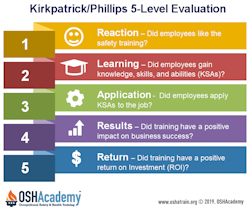The Five-Level Evaluation Model
To ensure that the training program follows ANSI/ASSE Z490.1 standards, we suggest using a five-level approach created by Dr. Donald Kirkpatrick and later modified by Dr. Jack Phillips.
In 1954, Donald Kirkpatrick created a four-level model to evaluate training. Later, in 1997, Dr. Phillips added a fifth level, focusing on how training affects profitability.
Phillips explains that once you determine the business impact of a learning program at Kirkpatrick's Level 4, you can convert that impact into money and compare it with the program's total cost to work out the Return on Investment (ROI). The Kirkpatrick/Phillips model is now the most commonly used method for evaluating training worldwide. It outlines five levels of outcomes as follows:
Kirkpatrick - Levels 1-4
- Reaction: Did the learners enjoy the safety training?
- Learning: Did the training increase the learners' safety knowledge, skills, and abilities (KSAs)?
- Application: Were the learners able to successfully use the KSAs on the job?
- Results: Did the safety training positively affect business key performance indicators (KPIs)?
Phillips - Level 5
- Return: Did the company see a positive return on the training investment (ROI), shown as a cost/benefit ratio?
The first three levels of training evaluation look at how the training affects the learner. The fourth and fifth levels assess how the safety training impacts the company. We'll discuss each of the five levels in more detail in Module 7.
Knowledge Check Choose the best answer for the question.
5-3. What does the first three levels of the Kirkpatrick/Phillips Five-Level evaluation method focus on?
You forgot to answer the question!

